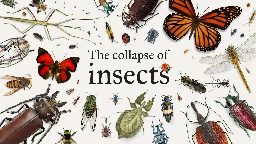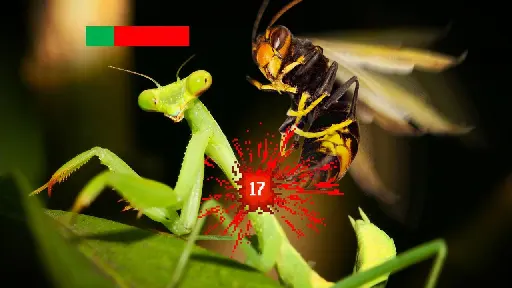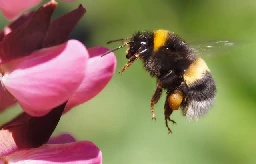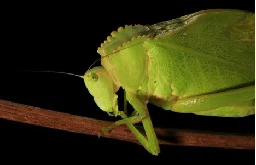Entomology
- Bird poop caterpillar

This bird poop caught my attention because it looked a bit too perfectly shaped, and when I looked at it closer its orange osmeteria came out.
Searching online, I suspect that this might be Papilio cresphontes. However, I see a lot of variation in the photos of Papilio cresphontes and so I am not sure if this the correct ID.
Found in Yucatan, Mexico.
- Parasitic 'horror' wasp that bursts from a fly's abdomen like an 'Alien' xenomorph discovered in Mississippi backyardwww.livescience.com Parasitic 'horror' wasp that bursts from a fly's abdomen like an 'Alien' xenomorph discovered in Mississippi backyard
Scientists accidentally discover new species of wasp that lays eggs inside living, adult fruit flies, which then burst from the hosts' abdomens while they're still alive.
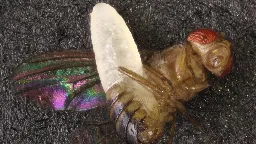
Researchers in Mississippi have discovered a previously unknown species of parasitoid wasp that matures inside the bodies of living, adult fruit flies before bursting out of them like a xenomorph in the "Alien" movies.
The sneaky predator, which researchers have named Syntretus perlmani, is the first wasp found to infect adult fruit flies — similar wasp species are known to target flies during their younger, more vulnerable larva and pupa life stages. The wasps are parasitoids rather than parasites because they always kill their hosts, while parasites usually don't.
A team of scientists came across the wasp by chance while collecting a common fruit fly called Drosophila affinis in their backyards in Mississippi. They published their findings Wednesday (Sep. 11) in the journal Nature.
- Air pollution makes it harder for bees to smell flowersknowablemagazine.org Air pollution makes it harder for bees to smell flowers
Contaminants can alter plant odors and warp insects’ senses, disrupting the process of pollination

- ‘I’ve never seen anything like it’: Videos show swarms of dragonflies invading R.I. beach - The Boston Globewww.bostonglobe.com ‘I’ve never seen anything like it’: Videos show swarms of dragonflies invading R.I. beach - The Boston Globe
Videos of the phenomenon posted on social media quickly racked up views, with commenters saying the swarms looked like a movie scene or the apocalypse.

>In North America, dragonfly migrations occur annually in late summer and early fall. Although it’s not clear what species of dragonfly caused a stir among sunbathers this weekend, Virginia “Ginger” Brown, the leading dragonfly expert in the Ocean State, told NBC 10 WJAR in 2021 that witnessing such an abundance of dragonflies along the coast is a miracle. > >While about 130 species of dragonflies are known in Rhode Island, Brown told WJAR that the Common Green Darner comprise the bulk of those that migrate on a yearly basis, with others accompanying their flights. > >The Common Green Darner is the “best-known migrant dragonfly,” according to the Vermont Center for Ecostudies. The large specimens are found in Rhode Island and are known for being fast travelers and “water-loving” insects striking in appearance, with translucent wings and green coloration, according to InsectionIdentification.org.
- It’s been a decade since the lanternfly landed in Pennsylvania. Is it as bad as we feared?www.inquirer.com It’s been a decade since the lanternfly landed in Pennsylvania. Is it as bad as we feared?
After a decade of living with spotted lanternfly in Pennsylvania, New Jersey, and Delaware, some things are better than we feared, and some are worse. But all that stomping helped.
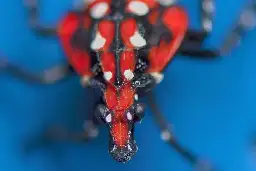
cross-posted from: https://beehaw.org/post/15196046
Linked article is about Pennsylvania, but note that Cornell recently announced these lanternflies have invaded the New York grape-growing region of the Finger Lakes: https://cals.cornell.edu/news/2024/07/spotted-lanternfly-found-finger-lakes-region
Also, they are up in Connecticut now: https://www.ctpublic.org/news/2024-07-25/spotted-lanternfly-connecticut-grapes-crops
> Researchers from Pennsylvania State University’s College of Agricultural Sciences used an economic assessment software program to estimate potential damage and said in the worst-case scenario the damage could climb to half a billion dollars annually.
> “I mean, look, it made it to Pennsylvania from China in one shot,” Walsh said. Lanternflies invaded the U.S. attached to a stone shipment sent to a local landscaping company.
> “The reality is that some of those assumptions have not played out as predicted. Far and away, lanternflies are not the fire and brimstone, doom and gloom situation that they were originally feared to be,” Walsh said. “Except for grapes — it’s been worse than expected for grapes.”
> While extremely disruptive to the wine and grape industry, the spotted lanternfly is not as damaging to hardwood trees used for timber as previously thought, according to 2023 research from Penn State’s Entomology Department.
> According to Penn State researchers, the heaviest hit vineyards lost up to 90% of their grapevines.
> Grape growers can’t just immediately replace a grapevine either. Creato said it takes up to three years for grapevines to bear fruit and five to seven years to be ready for wine.
> Walsh said there is a trend of lanternflies arriving in an area, growing in numbers rapidly for a few years, and then declining for another few years. “But in that sigh of relief, the question is then, ‘Why?’” he said.
> “It’s a complex bug that still has lots of secrets that we’re slowly working out,” Walsh said. “Everyday citizens reporting back information and doing the ‘lanternfly stomp’ as they went about their daily travels absolutely had a positive effect in slowing the spread.”
- Ants perform life saving operations — the only animal other than humans known to do sowww.livescience.com Ants perform life saving operations — the only animal other than humans known to do so
Florida ants perform amputations and clean wounds to prevent the spread of infection, scientists discover.

- Intracellular symbiont Symbiodolus is vertically transmitted and widespread across insect ordersacademic.oup.com Intracellular symbiont Symbiodolus is vertically transmitted and widespread across insect orders
Abstract. Insects engage in manifold interactions with bacteria that can shift along the parasitism–mutualism continuum. However, only a small number of ba

TL;DR: This paper describes the finding that there is a specific type of bacterium (Symbiodolus clandestinus) that lives inside of the tissues of several different insects. This bacterium appears to cause no disease, and it is hypothesized that it provides some useful metabolites that the insects are unable to produce themselves. The bacteria can be passed from the mother directly to her offspring. So, this appears to be a widespread symbiotic relation between a bacterium and insects.
The article goes into a lot more depth and describes some other examples of bacteria <-> insect interactions.
- Indigo Woodlouse, apparently maybe infected with Iridoviruswww.inaturalist.org Genus Iridovirus
Iridovirus from Soldiers Field Rd, Boston, MA, US on June 17, 2024 at 07:14 PM by otterx. Lots of them in my community garden plot in Boston MA.
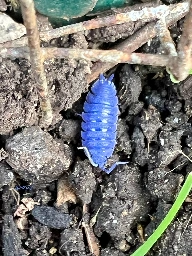
Courtesy of @otterX
- ID help

Saw these while looking at apartments but have no idea what they are. they were found mostly on carpet, but some were in other parts of the unit.
edit: after looking up the suggestion of carpet beetle I am fairly convinced that it is indeed what they are. I also saw a few adult beetles that look like one of the species found in photos online. thanks everyone.
- Nymph of the mangrove jewel bug (Calliphara nobilis)www.inaturalist.org Mangrove jewel bug (Calliphara nobilis)
Mangrove jewel bug from Woodlands, Singapore on June 2, 2024 at 10:24 AM by Soh Kam Yung
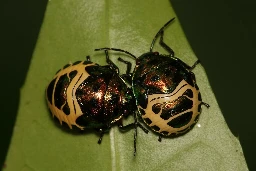
- What happens to little black ants without a queen?
I have some little black ants in my motorhome. I’m pretty sure I picked them up at my last stop in upstate New York but I’ve since driven far away from there. Wikipedia says little black ants nest in the soil so presumably I didn’t take their queen with me.
What’s going to happen to this group that hitched a ride? Are they likely to elect a new queen and go looking for a good nesting spot, or curl up and die, or what?
- Meet the Mad Hatterpillar aka Uraba lugens, aka The Gum Leaf Skeletoniser

cross-posted from: https://lemmy.ml/post/13641832
> Title photo by LS Perks > > Native to Australia (where else?) it can also be found as an invasive species in New Zealand. It feeds on Eucalyptus species and can become problematic, striping the leaves and damaging the trees hence it's actual name The Gum Leaf Skeletoniser > > As the caterpillar grows it sheds it's exoskeleton, during each molt the head portion of the previous exoskeleton stays attached to it's body resulting in a mini tower of empty heads > > “The molted head capsules start stacking early but they are not always visible, as the smaller ones get dislodged over time,” Hochuli said. “It’s not uncommon to see caterpillars with at least five old heads stacked on top of the one they are currently using.” Source > > The heads can reach up to 12mm tall, and look rather dandy! > > > ! > > Photo by Alan Henderson/Minibeast Wildlife > > > The several reasons for this, one is to look bigger and more intimidating to predators, another is to create a false target for a predator, and another is that the caterpillar uses the head piece as a weapon or shield to fend off insects with needle like mouth parts such as Assassin Bugs > > >....researchers removed the head stacks from some caterpillars, left them on others, and kept tabs on their survival once they were back in the field. Caterpillars who kept their extra heads were much more likely to survive in the field....Source > > > ! > > Photo by John Tann > > Unfortunately for The Mad Hatterpillar it's list of predators is long and relentless.... it has also evolved stinging hairs to complement it's head gear, and will writhe around to evade being grabbed, and if that isn't enough it will vomit out it's guts.... > > >“They’ll just spew out a whole bit of yucky green liquid that probably smells and tastes awful,” Henderson said. “And if they shove that in the face of the predator, it can turn them off.” Source > > ! > > Photo by Betty AN > > Once the Mad Hatterpillar is finished eating all the Eucalyptus it can, it pupates into a small brown, unremarkable moth with markings that help it camouflage on the trunks of it's food source > > > ! > > Photo by Victor Fazio
- Saga Ephippigera - the largest, carnivorous, bush cricket

-
Sagas are part of the family Tettigoniidae, commonly called katydids or bush crickets.
-
Saga Ephippigera is the largest cricket in the world, and can grow to near 20cm in length
-
There are 17 species of Saga across Europe, the Middle East, and central Asia, and one species that made it to America.
-
Unlike many other crickets that lay eggs in plant matter, Sagas lay their eggs \~20cm deep in damp soil, they can lay 20 eggs or more at a time. The S. Pedo eggs can survive buried for 4 years before hatching.
-
Saga's travel on the ground, though can jump short distances if needed.
-
They are mostly active at night and spend the day camouflaged in the growth by their yellow-brown or green colours.
-
Their front and middle limbs are barbed to help hold on to prey while they eat it with their powerful jaws
- While crickets generally survive mostly, or completely on plants, Saga's are predators that generally survive on grasshoppers and other insects but have been known to hunt much larger animals, from lizards to snakes, to birds. Here are some photos of one eating a sparrow: 1, 2, 3, 4, 5, 6
(source photos credit: Tzlil Landsman)
(if it isn't already obvious, I am a layperson who just came across a couple of these monsters on holiday, sharing information translated by a friend, apologies for any inaccuracies lol)
-
- Meet The Giant Wētā......The Colossus of Insects! Pictures and fun facts!

cross-posted from: https://lemmy.ml/post/12729136
> Title photo by Mike Locke > > >There are over 70 species of wētā in New Zealand > > >There are eleven species of giant wētā, most of which are larger than other wētā, despite the latter also being large by insect standards > > > >The name wētā comes from the Maori word wētāpunga, or “God of Ugly Things” .The genus name, Deinacrida, means “Terrible Grasshopper.” > > >The giant wētā’s close relatives include the Carnivorous Tusked Wētā, the Tree Wētā, and the Cave Wētā > > > >Giant wētā are endemic to New Zealand and all but one species are protected by law because they are considered at risk of extinction > > > ! > > New Zealand Giant Weta by Ricky Wilson > > >The largest species of Giant Wētā is the Little Barrier Island giant wētā, also known as the wētāpunga. One example reported in 2011 weighed 71 g (2.50 oz) > > >[Deinacrida mahoenui] is endemic to the area of Mahoenui, New Zealand, and the world population for some time was restricted to a single patch of introduced gorse on farmland. > > > ! > > Deinacrida mahoenui [MAHOENUI GIANT WETA] by Zoomology > > >Large species can be up to 10 cm (4 in), not inclusive of legs and antennae, with body mass usually no more than 35 g (1.2 oz). One gravid captive female reached a mass of about 70 g (2.47 oz), making it one of the heaviest insects in the world and heavier than a sparrow. This is, however, abnormal, as this individual was unmated and retained an abnormal number of eggs > > >Many giant wētā species are alpine specialists. Five species are only found at high elevation in South Island. The scree wētā D. connectens lives about 1,200 m (3,900 ft) above sea level [8] and freezes solid when temperatures drop below −5 °C (23 °F) > > > ! > > Deinacrida connectens > > >Fossils found from the Triassic period 190 million years ago show striking similarities to the wētā that inhabit New Zealand today > > Handsome Devil! > > ! > > Giant Weta - Maori "God Of Ugly Things" by Owen Calder > > Sources Giant Wētā, Deinacrida mahoenui, Deinacrida connectens, and Mental Floss
- A ‘Double Brood’ of Periodical Cicadas Will Emerge in 2024www.scientificamerican.com A Double Emergence of Periodical Cicadas Isn’t Cicada-geddon—It’s a Marvel
The U.S. is seeing two adjacent broods of periodical cicadas emerge this spring in a synchronized marvel of evolution
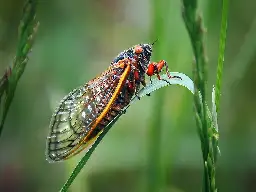
- Grasshopper

Sorry, no Lemming for scale (Wikipedia tells me a Lemming is '13–18 cm (5–7 in)'. So about the same size. I would imagine there are many about, but I only notice them when they are on doorframes or something.
They happily crawl onto my hand, my coworkers tell me they are delicious grilled, so I don't mention it and go for a walk in the forest.
Southwest Cambodia
- Please, enough with the dead butterflies! - Emily S. Damstrawww.emilydamstra.com Please, enough with the dead butterflies! - Emily S. Damstra
We all have pet peeves, even though there's a lot going on in the world that makes them pretty insignificant. While acknowledging that there are many more
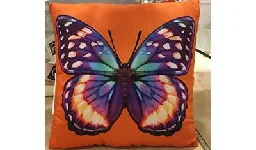
- The Butterfly Redemption | Hakai Magazinehakaimagazine.com The Butterfly Redemption | Hakai Magazine
How scientists, volunteers, and incarcerated women are finding hope and metamorphosis through supporting a struggling butterfly.
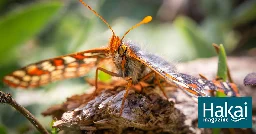
- The strange and turbulent global world of ant geopolitics | Aeon Essaysaeon.co The strange and turbulent global world of ant geopolitics | Aeon Essays
Over the past four centuries quadrillions of ants have created a strange and turbulent global society that shadows our own
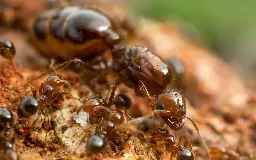
cross-posted from: https://sopuli.xyz/post/9346337
> […] > What is surprising is how poorly we still understand global ant societies: there is a science-fiction epic going on under our feet, an alien geopolitics being negotiated by the 20 quadrillion ants living on Earth today. It might seem like a familiar story, but the more time I spend with it, the less familiar it seems, and the more I want to resist relying on human analogies. Its characters are strange; its scales hard to conceive. Can we tell the story of global ant societies without simply retelling our own story? > > […] > Recognition looks very different for humans and insects. Human society relies on networks of reciprocity and reputation, underpinned by language and culture. Social insects – ants, wasps, bees and termites – rely on chemical badges of identity. In ants, this badge is a blend of waxy compounds that coat the body, keeping the exoskeleton watertight and clean. The chemicals in this waxy blend, and their relative strengths, are genetically determined and variable. This means that a newborn ant can quickly learn to distinguish between nest mates and outsiders as it becomes sensitive to its colony’s unique scent. Insects carrying the right scent are fed, groomed and defended; those with the wrong one are rejected or fought. > > […] > It is remarkable how irresistible the language of human warfare and empire can be when trying to describe the global history of ant expansion. Most observers – scientists, journalists, others – seem not to have tried. Human efforts to control ants are regularly described as a war, as is competition between invaders and native ants, and it is easy to see why comparisons are made between the spread of unicolonial ant societies and human colonialism. People have been drawing links between insect and human societies for millennia. But what people see says more about them than about insects.
- Insects All Around Uswww.texasobserver.org Insects All Around Us
Exploring the foliage for crawling, flying critters in one of Austin’s most beautiful nature preserves, Lady Bird Johnson Wildflower Center.
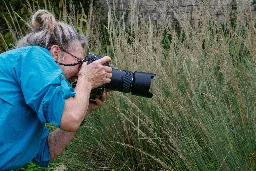
- Why flying insects gather at artificial light — Nature Communications (Study and Twitter thread attached)

cross-posted from: https://lemdro.id/post/5632417
> Study: https://doi.org/10.1038/s41467-024-44785-3 > > Twitter: https://x.com/samueltfabian/status/1752372075946299464#m > > If you have trouble with Twitter I recommend using Nitter (search Github)
- Living inside your grandmother – the wonderful world of aphidssimonleather.wordpress.com Living inside your grandmother – the wonderful world of aphids
How many of you realise that when you look at an aphid you are simultaneously looking at first, a clonal organism and secondly a mother, her daughter and her granddaughters, all housed in the same …
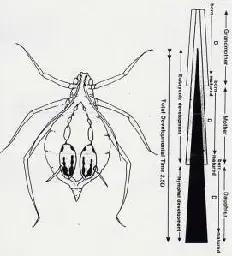
- Dolichomia amoenalis from Finca Heimatlos Eco Lodge and Farm, near Puyo, Ecuador.

https://twitter.com/EerikaSchulz/status/1749782576875622785
https://nitter.net/EerikaSchulz/status/1749782576875622785
No moths are harmed for these images thank you have a good evening
- Male and female dung beetles coordinate to roll balls, researchers findwww.theguardian.com Male and female dung beetles coordinate to roll balls, researchers find
Spider dung beetles thought to be a only example of animals other than humans working together without knowing object’s destination
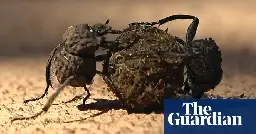
- Disproportionate declines of formerly abundant species underlie insect loss - Naturewww.nature.com Disproportionate declines of formerly abundant species underlie insect loss - Nature
An analysis of more than 500 sites distributed worldwide finds that declines in the abundance of terrestrial insects are attributable mainly to decreases in species that were formerly abundant, rather than being the result of losses of rare species.
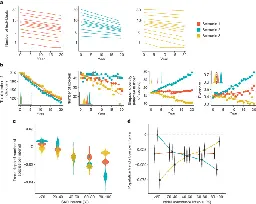
- Insect populations are declining at an unprecedented ratewww.reuters.com Insect populations are declining at an unprecedented rate
The most diverse group of organisms on the planet are in trouble and the consequences could be dire.
